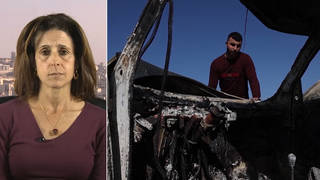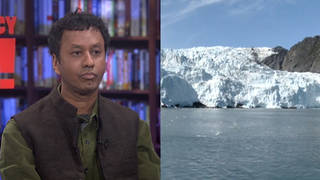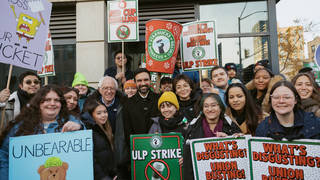
The Trump administration is finalizing plans to open one of the world’s last pristine wilderness regions, the Arctic National Wildlife Refuge, to oil and fracked gas drilling. Trump is pushing the drilling at a time when climate change is permanently altering the Arctic and devastating local communities. The plan calls for the creation of landing strips, drill pads, pipeline supports, a seawater treatment plant, 175 miles of roads, and other infrastructure in Alaska’s north coast. On Thursday, the House of Representatives voted to block the Trump administration from opening up Alaska’s Arctic National Wildlife Refuge; however, a companion bill is unlikely to pass the Republican-controlled Senate. From Charlotte, North Carolina, we speak with Subhankar Banerjee, a professor of art and ecology at the University of New Mexico and the author of “Arctic National Wildlife Refuge: Seasons of Life and Land.”
Transcript
AMY GOODMAN: This is Democracy Now! I’m Amy Goodman. The Trump administration is finalizing plans to open one of the world’s last pristine wilderness regions, the Arctic National Wildlife Refuge, to oil and fracked gas drilling. The Arctic refuge is rich in biodiversity, home to caribou, polar bears, musk oxen and other species. Millions of migratory birds gather there from across the world, and whales reside just offshore. It’s also been home to generations of indigenous people for thousands of years.
On Thursday, the House of Representatives voted to block the Trump administration from opening up Alaska’s Arctic National Wildlife Refuge, or ANWR. The bill had the support of Native Alaskans, who depend on migrating caribou herds for their subsistence. Members of the Gwich’in Steering Committee traveled to Washington, D.C., last week to lobby for the drilling ban. They said in a statement, “The Gwich’in and caribou have had a spiritual and cultural connection since time immemorial, the future of caribou and the future of the Gwich’in are the same. Harm to the caribou is harm to the Gwich’in way of life,” unquote. A companion bill to ban drilling in ANWR is not expected to pass the Republican-controlled Senate.
Meanwhile, the Trump administration has announced its final plan to offer oil and gas lease sales across more than a million-and-a-half acres of the Arctic refuge coastal plains. The plan calls for the creation of landing strips, drill pads, pipeline supports, a seawater treatment plant, 175 miles of roads, and other infrastructure in pristine wilderness along Alaska’s north coast.
Well, for more, we go to Charlotte, North Carolina, where we’re joined by Subhankar Banerjee, a professor of art and ecology at University of New Mexico. He’s the author of Arctic National Wildlife Refuge: Seasons of Life and Land and also editor of Arctic Voices: Resistance at the Tipping Point. He is also the co-curator of Species in Peril Along the Rio Grande.
Subhankar Banerjee, thank you so much for being with us again. Can you talk about what the Trump plans are for the Arctic and what this means? You’ve just returned from India.
SUBHANKAR BANERJEE: Thank you, Amy. Good to be with you. I’ll just preface this by saying you did an excellent segment with Mark on how the media has failed to cover the climate crisis.
What we are talking about in the Arctic National Wildlife Refuge is even — as I see it, is a bigger crisis than the climate crisis, that is unfolding before us — the media has miserably failed to inform the public — which is the crisis of extinction, what is — the scientists call it “biological annihilation.” Earlier this year, the United Nations IPBES released what is considered, for some of us, the grimmest warning of human history, that 1 million species on Earth, which is about more than 50% of the documented species on the planet, face extinction, many within decades. Last year, the Living Planet Report, issued by the World Wildlife Fund and the Zoological Society of London, highlighted that, since 1970, globally, monitored populations of vertebrates, which includes birds, fish, mammals, amphibians and reptiles, have declined, on average, in population 60%. In Central and Latin America, the decline is 89%. In India and in the Pacific, it’s the second worst, 64%. So, if you take all that, the biological annihilation is the most expansive crisis before us, if you consider the number of casualties taking right before us — happening right before us. And it is also the most challenging one to mitigate, because every aspect of modern life and its institutions are entangled with biological annihilation.
That said, probably the most ethical obligation before us is to protect critical nurseries and birthing grounds, where animals give birth and nurse their young and replenish their populations. The coastal plain of the Arctic National Wildlife Refuge, that I have experienced personally, in all seasons, is one such nursery — the most significant one in the entire Circumpolar North and one of the most important globally.
The Trump administration, since taking office, has aggressively pursued to open up the coastal plain to oil and gas drilling. And what they have done is a rushed process that has been undemocratic and unlawful. Jamie Rappaport Clark, president of the Defenders of Wildlife, said, following the vote, Amy, you mentioned, last Thursday, and Trump’s administration issuing the final environmental impact statement, that what the process they have followed is, quote-unquote, “categorically unlawful.”
So, last Thursday was a historic vote in the House, because two years ago, I spoke with you on Democracy Now! following the passage of the 2017 Republican Tax Cuts and Jobs Act, in which Alaska Senator Lisa Murkowski hijacked the budget reconciliation process and snuck in the drilling provision into the Tax Cuts and Jobs Act. Following that, the administration has pursued this process. They have undermined public participation, even though 70% of the American public, according to a poll conducted by the Yale University in 2017, opposed drilling in the Arctic National Wildlife Refuge.
They did not adequately consult with the indigenous communities, the Gwich’in communities you mentioned. Also, there are Iñupiat community members with whom I work very closely. They are concerned about food security, human rights and cultural practices.
And they have basically released an environmental impact statement that is deeply flawed. And following last month, Politico published a very important investigative piece in which they highlight how the administration has altered, suppressed, manipulated and deleted assessments by their own scientists. And there are three that are very significant. There are three scientists of the own organization, Bureau of Land Management, who formally have now complained: one on the polar bear assessment, one on — the anthropologist on the cultural impacts to the indigenous communities, and one on fish.
So they are suppressing science. They are suppressing indigenous concerns. And they’re basically about to destroy one of the world’s most important biological nurseries. This will not be allowed. We are fighting very hard, and we will defeat them.
AMY GOODMAN: I want to turn to a longtime Inuit activist, Sheila Watt-Cloutier, former chair of the Inuit Circumpolar Conference and a past winner of the Right Livelihood Award. She also wrote the book The Right to Be Cold: One Woman’s Fight to Protect the Arctic and Save the Planet from Climate Change. I asked her about the Trump administration’s plans to open up a part of Alaska’s Arctic refuge to oil drilling.
SHEILA WATT-CLOUTIER: Our atmosphere is reacting from this trauma that we have been putting onto our planet. Why would we continue to do this anywhere else in the world, much less in the Arctic, that has been the most negatively impacted? What kind of logic or what kind of wisdom is that? And so, of course, it should not be the Arctic that once again is targeted for — to continue and to maintain a sustainable way in which we have been going. It makes absolutely no sense, no economic sense and no environmental sense, no health sense. It just doesn’t make sense on any level. …
For any leaders in this world to move in the direction that is going to damage further the lands and the way of life of indigenous peoples, who have relied upon that for the ongoing of teaching, as I say, you know, because our lands and our wildlife, that’s our universities. That’s what we are all about in terms of that connection. So, again, going in that direction of an unsustainable way to damage further what is pristine, what is precious to us — because we protect what we love, and we love our ways of life. We love our land and the air that we breathe. And so, the world has to start to make those connections for themselves, as well, and fall back in love with nature and with how our wonderful — the wonders of our world is and our planet. It just — again, it is not wise to go in that direction.
AMY GOODMAN: Inuit activist and author Sheila Watt-Cloutier. Professor Banerjee, at this point, with the Trump administration saying they’re pushing for more drilling and fracking in the Arctic refuge, what are — and yet you have Congress with its historic vote — what do you see is the next step?
SUBHANKAR BANERJEE: The next step is that the administration will issue the record of decision within the next 30 days and will likely offer lease sales. But one thing that the public should know, that this fight is only heating up for in defense of protection. And what will happen is that even though they may offer lease sales, all of the major Big Oil players have departed. So, Shell folded their Alaska Arctic operation in 2017, after a $7 billion they sunk in the project. Last month, BP sold their entire Alaska operations to a small company in Houston, actually not so small, Hilcorp, that has a horrible record. And ConocoPhillips, the last remaining major player in Alaska’s Arctic Slope, has already announced that they will not bid on lease sales that may be offered on the Arctic National Wildlife Refuge. So, we are talking about probably a handful of —
AMY GOODMAN: We have five seconds.
SUBHANKAR BANERJEE: — a handful of companies, but also legal suits. So, what’s coming, because the administration has followed an illegal process, legal challenges are coming. And we just have to be vigilant and defeat them, until the next election.
AMY GOODMAN: Subhankar Banerjee, we want to thank you for being with us, professor of art and ecology at University of New Mexico, author of Arctic National Wildlife Refuge: Seasons of Life and Land.
Very Happy Birthday to Sam Alcoff! I’m Amy Goodman. Thanks so much for joining us.












Media Options